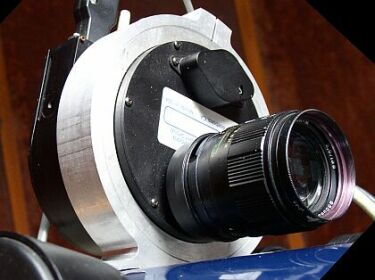|
SAVS uses the already existing infrastructure of the Observatory
(dome, LAN). Its hardware is composed of: CCD camera, simple
optics, camera mount and a control computer.
CCD Camera System
During first 16 months the SAVS system consisted of the SBIG ST-7
commercial CCD camera with Kodak KAF-0400E chip
equipped with near Johnson V filter. The CCD matrix had 765 x
510 pixels of 9 micron size and was cooled
thermoelectrically 30 degrees below the case temperature. In
practice it allowed to achieve a working temperature of
-10°C in summer and -30°C in winter. The camera was
connected to a control PC via a parallel port.
The camera was equipped with the SBIG CFW-8 filter wheel containing
5 filters. Observations were performed mostly in
near-Johnson V band and sporadically in B.
Starting from February 2004 the SAVS project entered its next
phase - monitoring of selected sky fields in three colors BVR.
The SBIG ST-7 CCD camera was temporarly replaced with the ST-8XE - a larger
and more sensitive model. The new detector had 1530 x 1020 pixels
of 9 micron size. The CCD matrix was cooled thermo-electrically 45
degrees below the case temperature. The camera was equipped with
a filter wheel containing the Johnson-Cousins UBVRI filter set,
closely approximating the standard system. That allowed to gather multicolor observations.
Since September 2004 observations have been performed with the upgraded CCD camera SBIG ST-7XE.
The upgrade was financed by UMK grant 431-A. The new more sensitive detector has 765x510 pixels of 9 micron size.
The CCD matrix is cooled thermo-electrically 45 degrees below the case temperature
- in practice 15 degrees lower than ST-7. The camera is connected to a control PC via a USB
port what makes data readout very fast. The new detector is equipped with a near-Johnson V filter.
Optics
An achromatic telephoto MC APO Telezenitar-M 135/2.8
is used as a optical system. It gave the field of view of 3
x 2 deg with a scale of 13.8 arcsec/pixel in case of SBIG ST-7 CCD camera.
The field of view of the SBIG ST-8 was 6 x 4 deg with a scale of 13.8
arcsec per pixel. The optics allows one to acquire sharp stellar images with typical FWHM of 2
pixels.

Camera Mount
The Meade LX200 telescope is used as a mount
for positioning our camera on required coordinates and tracking
the sky rotation. The CCD camera is attached at the top of the
telescope's tube. This setup allows to achieve good quality images
with exposure times up to 10 minutes. The mount
communicates with a PC via a serial port. The dome is
controlled by a dedicated ISA-bus controller card.

Control Computer
The control computer is located in the
control room in the dome building. It is a PC with Pentium 200 MHz
CPU, 32 MB RAM, 3 GB hard disk space and an ethernet card. The
observation are stored during a night on the local hard disk and
then copied via LAN to a work station for further reduction.
Control Software
A dedicated software was
written to control hardware: CCD Control Panel for the CCD camera and LX200 Control Panel for the mount and the dome's slit.
The software runs in an automatic mode performing
observations of selected fields. During daylight the
telescope is set to standby mode. After a twilight the tracking is
switched on and regular observations start in remote operation mode. The instrument is
positioned at required coordinates of the first program field and
then exposure starts. While an acquired CCD image is being
downloaded, compressed on-the-fly and saved on a local hard disk, the
telescope is already slewing toward a following target.
The list of targets loops during a night. Every field is observed
with priority and frequency set by an observer. Observations
usually last till dawn. If Sun's altitude is higher than
13.7° below local horizon the telescope is set to standby
mode and is awaiting upcoming twilight.
The role of observer was reduced to minimum. The human interaction
is required for opening and closing dome's slit, inspecting
acquired images and rejecting those of bad quality, archiving
collected data (about 400 MB a night) and finally running a
software pipeline for data reduction.

| 
